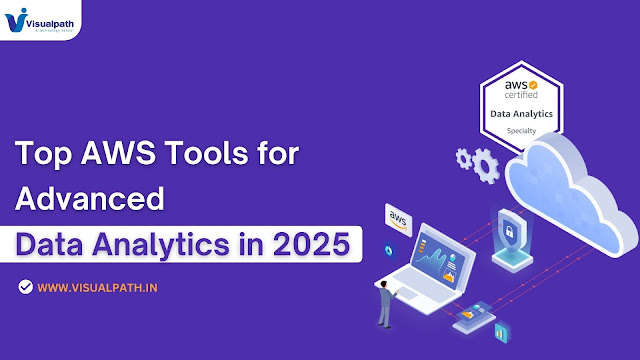- Get link
- X
- Other Apps
- Get link
- X
- Other Apps
Introduction to Data Analytics in AWS
Data Analytics plays a
pivotal role in the modern business world, helping organizations derive
actionable insights from their data to drive decision-making. AWS, a leader in
cloud technology, offers a robust ecosystem for data analytics, providing tools
to process, analyze, and visualize data effectively. Pursuing an AWS Data Engineering Course can
empower professionals to master these tools and build scalable data solutions
tailored to industry demands.
AWS's comprehensive suite of services simplifies complex data workflows, making it accessible for organizations of all sizes. Professionals can enhance their expertise by enrolling in AWS Data Engineering online training, which focuses on real-world applications of AWS analytics tools.
 |
| Top AWS Tools for Advanced Data Analytics in 2025 |
Top AWS Tools for Advanced Data Analytics
AWS offers a suite of services that support every stage of the data analytics
process. Let’s explore some of the top tools shaping the future of analytics:
1.
Amazon Redshift
Amazon Redshift is a fast, scalable, and fully managed cloud data warehouse. It
supports analytics on petabyte-scale datasets and integrates seamlessly with
other AWS services. With Redshift Spectrum, users can directly query data
stored in Amazon S3 without additional data-loading steps. This powerful tool
is a key focus area in any AWS Data Engineering Course due to its
relevance in modern data engineering.
2.
AWS Glue
AWS Glue is a serverless ETL
(Extract, Transform, Load) service that simplifies data preparation for
analytics. Its automation capabilities and cost-effectiveness make it ideal for
handling large datasets. AWS Glue is frequently highlighted in AWS Data Engineering online training,
especially for professionals interested in building efficient ETL pipelines.
3.
Amazon Kinesis
Real-time data processing has become a necessity, and Amazon Kinesis is at the
forefront of this capability. It enables businesses to analyze streaming data
in real-time, making it a favourite among data engineers specializing in
real-time analytics solutions.
4. Amazon QuickSight
Data visualization is essential for presenting insights, and Amazon QuickSight
provides an intuitive platform for creating interactive dashboards. Its ability
to integrate with other AWS services makes it a vital tool in the analytics
ecosystem, especially for organizations seeking advanced visualization
solutions.
Why Learn AWS Data Analytics?
Learning AWS Data Analytics provides several key benefits, making it a valuable
skill for professionals:
- Scalability and Flexibility: AWS tools
are designed to handle varying data volumes, ensuring scalability without
compromising performance.
- Cost Efficiency: The pay-as-you-go pricing model allows
businesses to control costs effectively, an essential feature for startups
and enterprises alike.
- End-to-End Integration: AWS services
work seamlessly together, enabling the creation of streamlined data
pipelines and analytics workflows.
- Career Advancement: Completing
an AWS
Data Engineering Course or AWS
Data Engineering online training enhances your credentials, opening
doors to high-demand roles in cloud data analytics.
Professionals equipped with AWS analytics skills can handle complex data
engineering challenges and build innovative solutions that drive business
growth.
Conclusion:
AWS has transformed how businesses approach Data Analytics, offering tools catering to diverse analytics needs. Services like Amazon
Redshift, AWS
Glue, Amazon Kinesis, and Amazon
QuickSight enable organizations to efficiently derive valuable insights from their data. For individuals, learning AWS analytics through an AWS Data Engineering Course or AWS Data Engineering online training
is the key to unlocking opportunities in the growing field of cloud-based data
engineering.
With AWS's powerful tools and the right training, you can not only
master the art of data analytics but also contribute significantly to
data-driven innovation in 2025 and beyond.
Visualpath is the Best Software Online Training Institute in
Hyderabad. Avail complete AWS Data Engineering with Data
Analytics
worldwide. You will get the best course at an affordable cost.
Attend
Free Demo
Call on -
+91-9989971070.
WhatsApp: https://www.whatsapp.com/catalog/919989971070/
AWS Data Engineer online course
AWS Data Engineering Training Institute
AWS DataEngineering online training
AWS DataEngineering training in Hyderabad
Data Engineering in Hyderabad
- Get link
- X
- Other Apps
Comments
Post a Comment